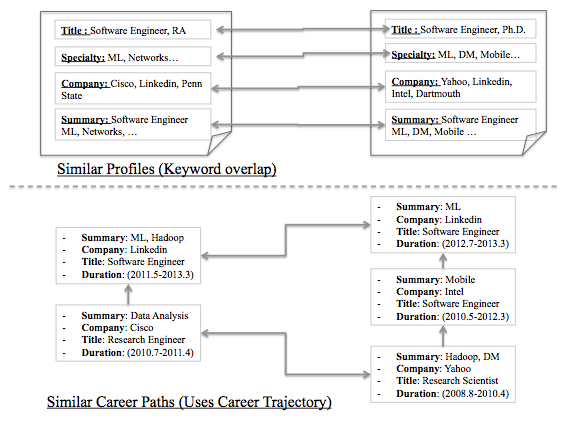Developing the new Similar Career Path score
August 12, 2014
We built our Similar Profiles algorithm using a variety of features that represent our members’ professional identity, such as their job titles, the companies they’ve worked at, their skills, and the schools they’ve attended. We originally developed this algorithm to help recruiters find similar profiles for hiring based on keywords present in profiles. But over time, we’ve recognized the potential of Similar Profiles to be a foundation for uncovering newer kinds of insights for our members.
So we revamped our Similar Profiles algorithm to create a new member feature on LinkedIn: “Professionals Like You”. Now, in addition to using keywords overlap for computing profile similarity, we also compute a Similar Career Path (SCP) score. This score is built upon the intuition that people would be more similar if they have had similar rate of promotions at similar kinds of companies holding similar kinds of roles. Our algorithmic approach is inspired by DNA sequence alignment in Bioinformatics - which makes this our first attempt at professional cloning!
For SCP, we treat each member profile as a time-sequence of nodes which represent one particular position in a member's professional experience e.g. title, company, location, time duration, summary, seniority/title/company change from previous position. We first align the nodes between two profiles by learning similarity measure between two profile positions. We then use dynamic programming to find the most parallel alignment of career sequences using the node-level similarity measure as defined above. We compute the overall similarity between career sequences as a sum of similarity between pairs of aligned nodes from the two career sequences.
This schematic gives a visual description of the basic approach:

The SCP score is especially useful for professionals in early stages of their careers. It allows them to compare their career paths with those of their successful senior peers, which in turn helps them preview their own possible career trajectories. It can also help young professionals choose schools and areas of specialization, as well as decide which skills they need to acquire to achieve their professional goals. Essentially, it allows professionals to identify role models and follow in their footsteps.
We also recently launched this new Similar Profiles algorithm in LinkedIn Recruiter as part of the new Profile 2.0. The new Similar Profiles on Recruiter profile page is now one of our most popular features, second only to InMail feature.
So we revamped our Similar Profiles algorithm to create a new member feature on LinkedIn: “Professionals Like You”. Now, in addition to using keywords overlap for computing profile similarity, we also compute a Similar Career Path (SCP) score. This score is built upon the intuition that people would be more similar if they have had similar rate of promotions at similar kinds of companies holding similar kinds of roles. Our algorithmic approach is inspired by DNA sequence alignment in Bioinformatics - which makes this our first attempt at professional cloning!
For SCP, we treat each member profile as a time-sequence of nodes which represent one particular position in a member's professional experience e.g. title, company, location, time duration, summary, seniority/title/company change from previous position. We first align the nodes between two profiles by learning similarity measure between two profile positions. We then use dynamic programming to find the most parallel alignment of career sequences using the node-level similarity measure as defined above. We compute the overall similarity between career sequences as a sum of similarity between pairs of aligned nodes from the two career sequences.
This schematic gives a visual description of the basic approach:

The SCP score is especially useful for professionals in early stages of their careers. It allows them to compare their career paths with those of their successful senior peers, which in turn helps them preview their own possible career trajectories. It can also help young professionals choose schools and areas of specialization, as well as decide which skills they need to acquire to achieve their professional goals. Essentially, it allows professionals to identify role models and follow in their footsteps.
We also recently launched this new Similar Profiles algorithm in LinkedIn Recruiter as part of the new Profile 2.0. The new Similar Profiles on Recruiter profile page is now one of our most popular features, second only to InMail feature.